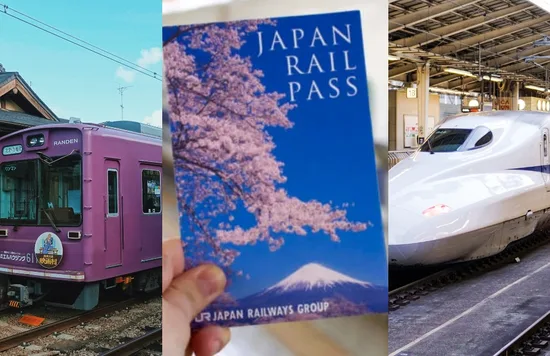Train travel in Japan is exceedingly easy and convenient, thanks to its advanced railway networks. Plus, there’s the Japan Rail Pass (or JR Pass, for short!) to make everything easier.
The Japan Rail Pass is a single pass that gives you unlimited access to trains and other modes of transportation under the Japan Railways Group. This saves you time and money from buying multiple train tickets per ride!
Find out more about this all-in-one pass with this ultimate JR Pass Guide:
Still need a bit more convincing? Here are all the great perks of using the JR Pass and why you should definitely use it:
Now that you know the basics of the JR Pass you might be wondering, does the JR pass cover the specific train I need to ride?
It’s useful to know all the trains and other modes of transportation covered by your pass so you don’t end up hopping on a train you don’t have access to and end up paying extra for.
There are lots of trains and train lines in Japan covered by the JR Pass, so this guide will keep you handy during your Japan trip!
1. What is included in my Japan Rail Pass?
Railway inclusions
Your JR Pass covers trains under the Japan Railways network. This includes the N’EX or Narita Express, Limited Express, Express, and Local trains. You can also access the Tokyo Monorail to/from Haneda Airport for easy travel to the city after arriving in Japan.
The pass also includes all Shinkansen Lines, including of Nozomi and Mizuho trains. This will allow seamless travel for all the pass-holders in Japan.
Nozomi trains are the fastest on the Tokaido and Sanyo Shinkansen lines, while Mizuho trains serve Sanyo and Kyushu Shinkansen. However, pass holders need a supplemental ticket for these swift services, each with specified fares from Tokyo:
Tokyo-Nagoya: ¥4180
Tokyo-Kyoto: ¥4960
Tokyo-Shin Osaka: ¥4960
Tokyo-Shin Kobe: ¥4960
Tokyo-Himeji: ¥5390
Tokyo-Okayama: ¥5,930
Tokyo-Hiroshima: ¥6500
Tokyo-Hakata: ¥8140
These supplementary tickets ensure access to the fastest and most efficient train services.
Additionally, the JR Pass also covers non-JR trains with access to isolated JR lines. There are a few non-JR trains with entries to remote, isolated JR lines you wouldn’t be able to access using the JR pass alone, but if you have a pass, you can get on and off the stations that provide a transfer to JR lines. These lines are:
- Aoimori Railway between Aomori
- Noheji and Hachinohe to access the JR Ominato Line to the Shimokita Peninsula
- IR Ishikawa Railway between Kanazawa and Tsubata to access the JR Nanao Line to the Noto Peninsula
- Ainokaze Toyama Railway between Toyama and Takaoka to access the JR Himi Line and JR Johana Line
Your Japan Rail Pass can also be used on the JR line parts of these through-services:
Kanto Area:
- JR Chuo/Sobu line through-services to Tokyo Metro Tozai Line (valid for Mitaka-Nagano and Nishi-Funabashi-Tsudanuma);
- JR Joban line through-services to Tokyo Metro Chiyoda Line (valid for Kashiwa/Abiko/Toride-Ayase);
- JR Kawagoe/Saikyo line through-services to Rinkai Line (valid for Kawagoe-Osaki)
Joetsu Area:
- Hokutetsu Express through-services between Naotetsu and Echigo Yuzawa (valid for Naotetsu-Saigata and Echigo-Yuzawa-Muikamichi)
Kyushu Area:
- JR Chikuhi/Karatsu through-services to Fukuoka Subway Kuko line (valid for Nishi-Karatsu-Meinohama)
Tohoku Area:
- JR Hanawa line through-services to Iwate Galaxy Railway (valid for Odate-Koma);
- JR Tohoku line through-services to Iwate Galaxy Railway (valid for Kitakami-Morioka)
- JR Tohoku line through-service to Sendai Airport (valid for Natori-Sendai Airport)
Bus inclusions
Similar to trains, your JR Pass is valid only on local buses under JR, which doesn’t include highway buses. While there aren’t that many buses you can access using your pass, you can still use it to ride local buses after more long-distance travels on trains.
Foreign tourists often find these bus services useful:
- Yamaguchi - Hagi
- Kyoto Station - Ryoanji - Takao
- Kanazawa Station - Kenrokuen
- JR buses to Lake Towad
- JR tourist loop bus in Hiroshima
- JR city buses around Sapporo
- JR local bus to Kusatsu Onsen
- BRT services on Sanriku Coast
Ferry inclusions
You can catch the JR-WEST Miyajima Ferry between Miyajima and Miyajimaguchi using your JR Pass.
2. What isn’t included in my JR Pass?
Railway exclusions
The JR Pass does not cover trains that are not operated by Japan Railways, such as the Odakyu Line, Tokyo Subway, and Keio Line.
Some services under the JR pass require additional base, express charges, or surcharges, which will be collected on the respective trains. Or it can be charged as an adjustment fare at your destination station. These services are:
- Fuji excursion services and JR Chuo line through-services between Otsuki and Kawaguchiko;
- Hashidate / Tango relay services (Fukuchiyama-Miyazu, Miyazu-Nishi-Maizuru, Miyazu-Toyooka).
- Mt. Fuji services between Shinjuku and Matsuda;
- Nanki / Mie services between Kawarada and Tsu;
- Odoriko and JR Ito line services between Ito and Izukyu-Shimoda;
- Shimanto / Ashizuri services between Kubokawa and Sukumo, including JR Yodo line through-service between Wakai and Kubokawa;
- Shirayuki services between Naoetsu, Joetsumyoko and Arai;
- Spacia, Spacia Kinugawa, and Kinugawa services between Kurihasi and Tobu-Nikko/Kinugawa Onsen;
- Super Hakuto and Super Inaba services between Kamigori and Chizu;
- Super Odoriko services between Mishima and Shuzenji.
Bus and ferry exclusions
Aside from the specific bus and ferry services mentioned above, the JR Pass does not cover most busses and ferries in Japan.
What are the differences between the trains included in the JR Pass?
There are various types of trains you can access using your JR Pass. First is the Shinkansen (Japanese term for bullet train) or high-speed train, which allows speedy long-distance travel. Japan currently has nine Shinkansen lines, which allow you to travel the long and thin archipelago easily.
Limited Express trains, a.k.a. Special Express, have limited stops in most major cities and train stations that are the most often used. It’s the fastest train in Japan besides the Shinkansen, though it covers more cities than the latter.
The difference between Express trains and Limited Express trains is that the former is a bit slower and takes longer to traverse the same route. However, they have more stops than Limited Express trains.
Rapid trains, on the other hand, have more stops than Express trains. Local trains have a stop at every station. However, they are the slowest type of train and better suited for short-distance travel.
You can access all of these with your Japan Rail Pass.
Now that you know all the trains, buses and ferries you can hop on, here’s how you can explore Japan with your JR pass:
Written by: Rohana Monzon














![[Updated] Complete List Of Official Nationwide MCO SOP 2021](https://res.klook.com/image/upload/fl_lossy.progressive,q_85/c_fill,w_160,h_104/v1633858858/blog/iso56uzsphmdguixkvzh.webp)





![[Updated] Complete List Of Official Nationwide MCO SOP 2021](https://res.klook.com/image/upload/fl_lossy.progressive,q_85/c_fill,w_410,h_264/v1633858858/blog/iso56uzsphmdguixkvzh.webp)







